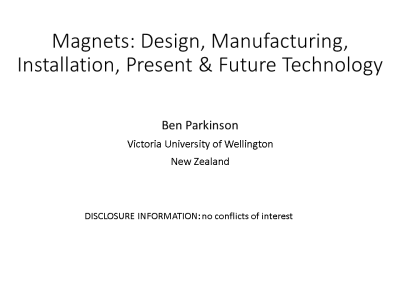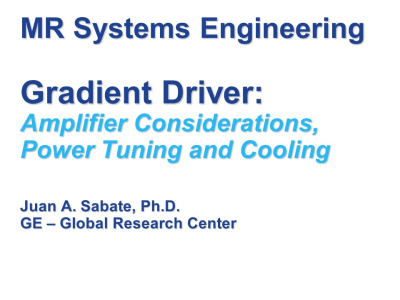Joint Annual Meeting ISMRM-ESMRMB • 16-21 June 2018 • Paris, France

| Weekend Educational Course MR Systems Engineering |
|||||||||||||||||
|
MR Systems Engineering: Part 1
Weekend Course ORGANIZERS: Gregor Adriany, Christoph Juchem, Mary McDougall, Greig Scott
Saturday, 16 June 2018
Skill Level: Basic to Intermediate
Session Number: WE-02A
Overview This one-day educational course is targeted at scientists and clinicians interested in understanding the engineering of magnetic resonance systems on a subsystems level. In a series of lectures from experts in MR Systems Engineering, attendees will first be provided with an overview of an MR system, and then learn about the design of magnet, gradients and shim systems, as well as the operation of the radiofrequency (RF) electronic subsystems that interface with RF coils. Issues relating to the site preparation and installation of new MR systems will also be discussed. In addition attendees will be taught about the key elements of MR safety as it relates to peripheral nerve stimulation (low frequency electromagnetic field interactions with the body) as well as energy deposition in the body from high frequency electromagnetic field interactions. The compatibility of medical devices and implants with an MRI scanner will be discussed. This course is aimed at scientists and clinicians with a technical background and interest in MR systems hardware. It is expected to provide attendees with an understanding of fundamental aspects of MR system operation. Target Audience Scientists and clinicians who are starting to work in the field of MRI and would like to have an overview of the engineering of an MR system. More experienced researchers in particular areas of MR Engineering will also benefit from hearing about recent advances in the engineering of MR systems. Educational Objectives As a result of attending this course, participants should be able to: -Discuss the basic subsystems hardware components of an MRI scanner, including how they interact and function; -Describe issues related to installing a new MR scanner, including space, venting, power and cooling considerations; -Recognize practical limitations in the design and construction of magnets, gradients and shim systems; -Identify the basic mechanisms by which medical devices interact with the magnet and gradients within an MRI scanner; -Describe the interactions of electromagnetic fields (both low frequency gradient switching and high frequency RF) with the human body; and -Explain the RF electronic subsystems that interface with RF coils, including interactions between separate transmit and receive coils.
|
|||||||||||||||||
|
MR Systems Engineering: Part 2
Weekend Course ORGANIZERS: Gregor Adriany, Christoph Juchem, Mary McDougall, Greig Scott
Saturday, 16 June 2018
Skill Level: Basic to Intermediate
Session Number: WE-02B
Overview This one-day educational course is targeted at scientists and clinicians interested in understanding the engineering of magnetic resonance systems on a subsystems level. In a series of lectures from experts in MR systems engineering, attendees will first be provided with an overview of an MR system, and then learn about the design of magnet, gradients and shim systems, as well as the operation of the radiofrequency (RF) electronic subsystems that interface with RF coils. Issues relating to the site preparation and installation of new MR systems will also be discussed. In addition, attendees will be taught the key elements of MR safety as it relates to peripheral nerve stimulation (low frequency electromagnetic field interactions with the body) as well as energy deposition in the body from high frequency electromagnetic field interactions. The compatibility of medical devices and implants with an MRI scanner will be discussed. This course is aimed at scientists and clinicians with a technical background and interest in MR systems hardware. It is expected to provide attendees with an understanding of fundamental aspects of MR system operation. Target Audience Scientists and clinicians who are starting to work in the field of MRI and would like to have an overview of the engineering of an MR system. More experienced researchers in particular areas of MR engineering will also benefit from hearing about recent advances in the engineering of MR systems. Educational Objectives As a result of attending this course, participants should be able to: -Discuss the basic subsystems hardware components of an MRI scanner, including how they interact and function; -Describe issues related to installing a new MR scanner, including space, venting, power and cooling considerations; -Recognize practical limitations in the design and construction of magnets, gradients and shim systems; -Identify the basic mechanisms by which medical devices interact with the magnet and gradients within an MRI scanner; -Describe the interactions of electromagnetic fields (both low frequency gradient switching and high frequency RF) with the human body; and -Explain the RF electronic subsystems that interface with RF coils, including interactions between separate transmit and receive coils.
|
|||||||||||||||||
| Back | |||||||||||||||||
| The International Society for Magnetic Resonance in Medicine is accredited by the Accreditation Council for Continuing Medical Education to provide continuing medical education for physicians. |



